2014 MERCEDES-BENZ B-CLASS SPORTS spare tire
[x] Cancel search: spare tirePage 332 of 360
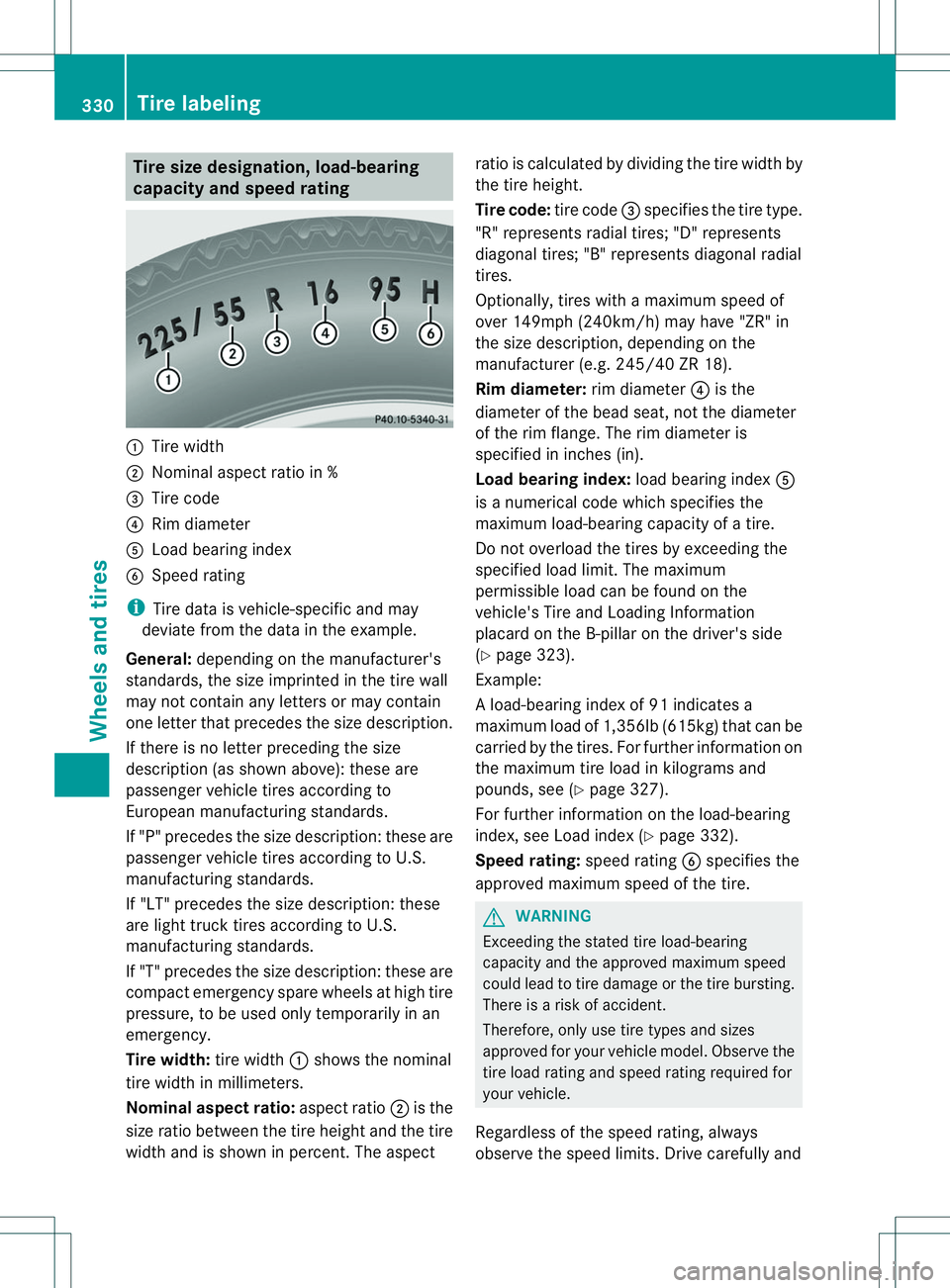
Tire size designation
,load-bearing
capacit yand speed rating 001A
Tire width
0010 Nominal aspec tratio in %
0023 Tire code
0021 Rim diameter
001E Load bearing index
0024 Speed rating
i Tire dat aisvehicle-specific and may
deviate from th edataint heexample.
General: dependingonthemanufacturer's
standards ,the sizeimprinted in th etirew all
may no tcontai nany letters or may contain
on elette rthat precedes the size description.
If there is no letter preceding the size
description (as shown above): these are
passenger vehicle tires according to
European manufacturing standards.
If "P" precedes the size description: these are
passenger vehicle tires according to U.S.
manufacturing standards.
If "LT" precedes the size description: these
are light truck tires according to U.S.
manufacturing standards.
If "T" precedes the size description: these are
compact emergency spare wheels at high tire
pressure, to be used only temporarily in an
emergency.
Tire width: tire width001Ashows the nominal
tire width in millimeters.
Nominal aspect ratio: aspect ratio0010is the
size ratio between the tire height and the tire
width and is shown in percent.T he aspectratio is calculated by dividing the tire width by
the tire height.
Tire code:
tire code0023specifies the tire type.
"R" represents radial tires; "D" represents
diagonal tires; "B" represents diagonal radial
tires.
Optionally, tires with amaximum speed of
over 149mph (240km/h) may have "ZR"in
the size description, depending on the
manufacturer (e.g. 245/40 ZR 18).
Rim diameter: rim diameter0021is the
diameter of the bead seat, not the diameter
of the rim flange. The rim diameter is
specified in inches (in).
Load bearing index: load bearing index001E
is an umerical code which specifies the
maximum load-bearing capacity of atire.
Do not overload the tires by exceeding the
specified load limit. The maximum
permissible load can be found on the
vehicle's Tire and Loading Information
placard on the B-pillar on the driver's side
(Y page 323).
Example:
Al oad-bearing index of 91 indicates a
maximum load of 1,356lb (615kg) that can be
carried by the tires. For further information on
the maximum tire load in kilograms and
pounds, see (Y page 327).
For further information on the load-bearing
index, see Load index (Y page 332).
Speed rating: speed rating0024specifies the
approved maximum speed of the tire. G
WARNING
Exceeding the stated tire load-bearing
capacity and the approved maximum speed
could lead to tire damage or the tire bursting.
There is arisk of accident.
Therefore, only use tire types and sizes
approved for your vehicle model. Observe the
tire load rating and speed rating required for
your vehicle.
Regardless of the speed rating, always
observe the speed limits. Drive carefully and 330
Tirel
abelingWheels and tires
Page 336 of 360
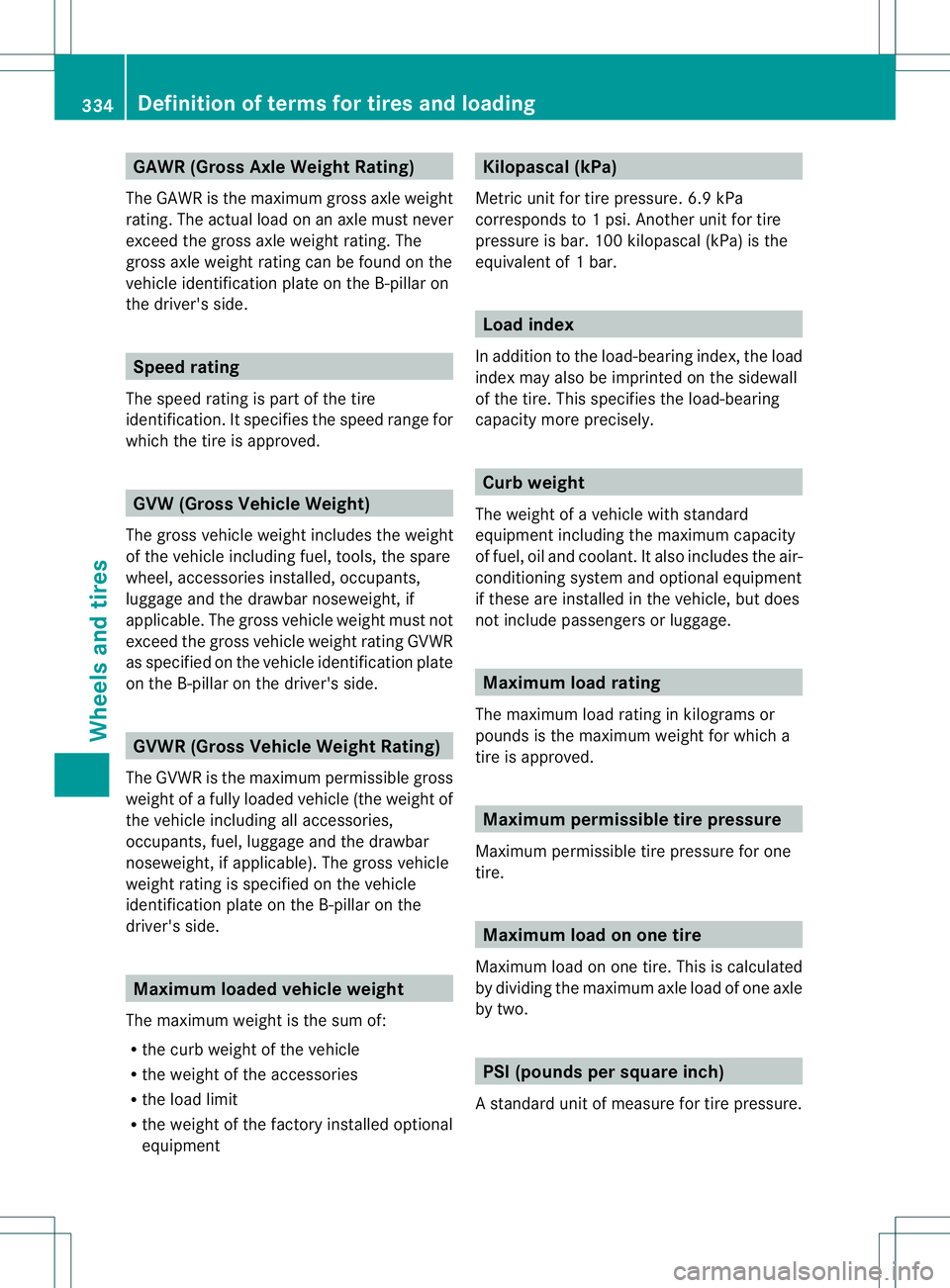
GAWR (Gross AxleW
eight Rating)
The GAWR is the maximu mgross axle weight
rating. The actua lloa donana xle must never
exceed the gross axle weight rating. The
gross axle weight rating can be found on the
vehicl eidentification plate on the B-pillar on
the driver's side. Speed rating
The spee drating is part of the tire
identification. It specifies the spee drange for
which the tire is approved. GVW (Gross Vehicle Weight)
The gross vehicl eweight includes the weight
of the vehicl eincluding fuel ,tools, the spare
wheel, accessories installed, occupants,
luggage and the drawbar noseweight, if
applicable.T he gross vehicle weight must not
exceed the gross vehicle weight rating GVWR
as specified on the vehicle identification plate
on the B-pillar on the driver's side. GVWR (Gross Vehicle Weight Rating)
The GVWR is the maximum permissible gross
weight of afully loaded vehicle (the weight of
the vehicle including all accessories,
occupants, fuel, luggage and the drawbar
noseweight, if applicable). The gross vehicle
weight rating is specified on the vehicle
identification plate on the B-pillar on the
driver's side. Maximum loaded vehicle weight
The maximum weight is the sum of:
R the curb weight of the vehicle
R the weight of the accessories
R the load limit
R the weight of the factory installed optional
equipment Kilopascal (kPa)
Metric unit for tire pressure. 6.9 kPa
corresponds to 1psi. Another unit for tire
pressure is bar. 100 kilopascal (kPa) is the
equivalent of 1bar. Load index
In addition to th eload-bearing index ,the load
index may also be imprinted on th esidewall
of th etire. This specifie sthe load-bearing
capacity more precisely. Curb weight
The weight of avehicle with standard
equipment including the maximum capacity
of fuel, oil and coolant. It also includes the air-
conditioning system and optional equipment
if these are installed in the vehicle, but does
not include passengers or luggage. Maximum load rating
The maximum load rating in kilograms or
pounds is the maximum weight for which a
tire is approved. Maximum permissible tire pressure
Maximum permissible tire pressure for one
tire. Maximum load on one tire
Maximum load on one tire. This is calculated
by dividing the maximum axle load of one axle
by two. PSI (pounds per squarei
nch)
As tandar dunitofm easure for tire pressure. 334
Definition of terms for tires and loadingWheels and tires
Page 338 of 360
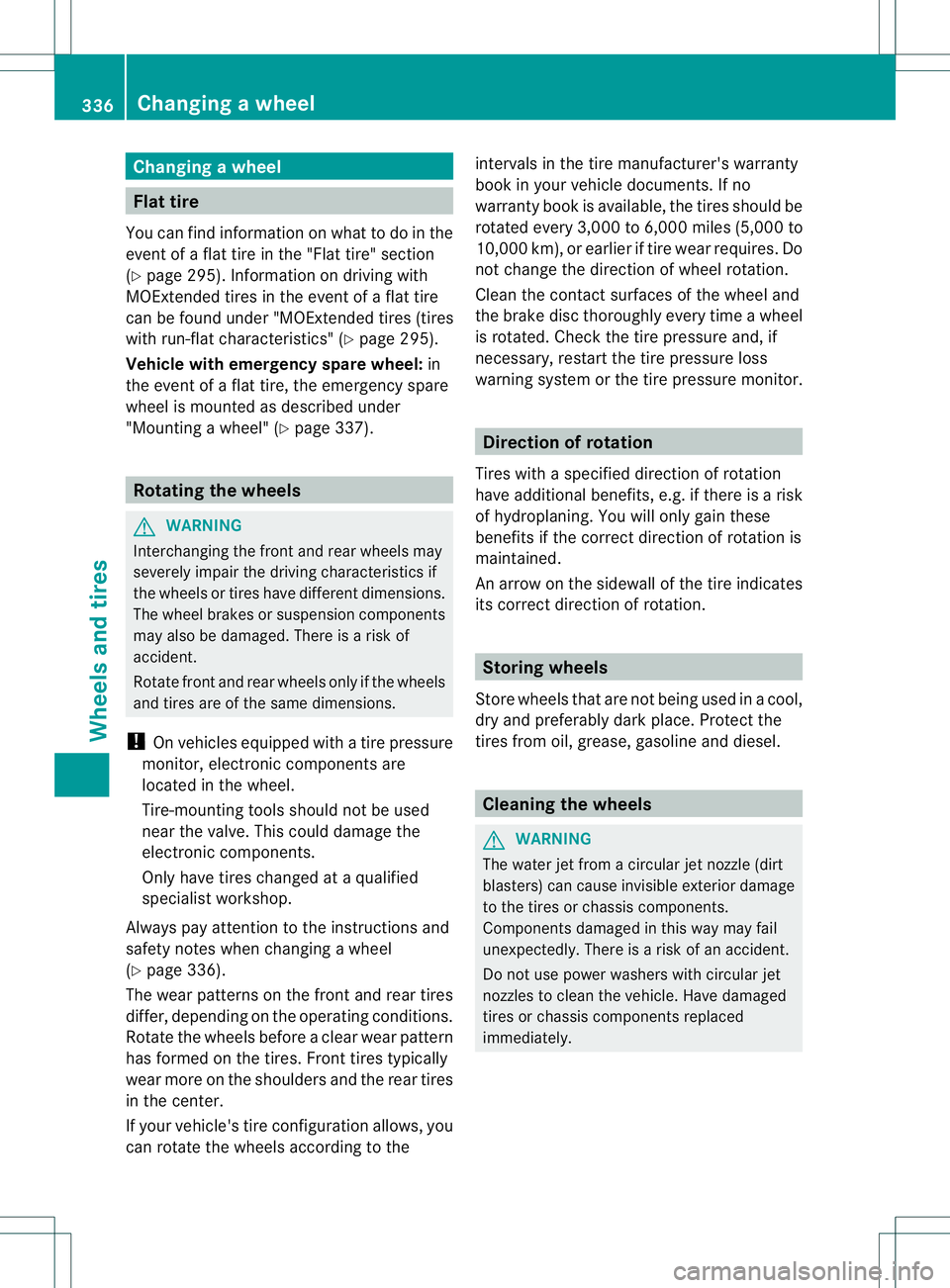
Changing
awheel Flat tire
You can find information on wha ttodointhe
event of aflat tire in the "Flat tire" section
(Y page 295). Information on driving with
MOExtended tires in the event of aflat tire
can be found under "MOExtended tires (tires
with run-flat characteristics" (Y page 295).
Vehicle with emergency sparew heel:in
the event of aflat tire, the emergenc yspare
wheel is mounted as described under
"Mounting awheel" ( Ypage 337). Rotating the wheels
G
WARNING
Interchangin gthe front and rear wheels may
severely impair the driving characteristics if
the wheels or tires have different dimensions.
The wheel brakes or suspension components
may also be damaged. There is arisk of
accident.
Rotate front and rear wheels only if the wheels
and tires are of the same dimensions.
! On vehicles equipped with atire pressure
monitor, electronic components are
located in the wheel.
Tire-mounting tools should not be used
near the valve. This could damage the
electronic components.
Only have tires changed at aqualified
specialist workshop.
Always pay attention to the instructions and
safety notes when changing awheel
(Y page 336).
The wear pattern sonthe front and rear tires
differ, depending on the operating conditions.
Rotate the wheels before aclear wear pattern
has formed on the tires. Frontt ires typically
wear more on the shoulders and the rear tires
in the center.
If your vehicle's tire configuration allows, you
can rotatet he wheels according to the intervals in the tire manufacturer's warranty
book in your vehicle documents. If no
warranty book is available, the tires should be
rotated every 3,000 to 6,000 miles
(5,000 to
10,000 km), or earlier if tire wear requires. Do
not change the direction of wheel rotation.
Clean the contac tsurface softhe wheel and
the brake disc thoroughly every time awheel
is rotated. Check the tire pressure and, if
necessary, restart the tire pressure loss
warning system or the tire pressure monitor. Direction of rotation
Tires with aspecified direction of rotation
have additional benefits, e.g. if there is arisk
of hydroplaning. You will only gain these
benefits if the correct direction of rotation is
maintained.
An arrow on the sidewall of the tire indicates
its correct direction of rotation. Storing wheels
Storew heels that are not being used in acool,
dry and preferably dark place. Protect the
tires from oil, grease, gasoline and diesel. Cleaningt
he wheels G
WARNING
The water jet from acircular jet nozzle (dirt
blasters) can cause invisible exterior damage
to the tires or chassis components.
Components damaged in this way may fail
unexpectedly. There is arisk of an accident.
Do not use power washers with circular jet
nozzles to clean the vehicle. Have damaged
tires or chassis components replaced
immediately. 336
Changing
awheelWheels and tires
Page 344 of 360
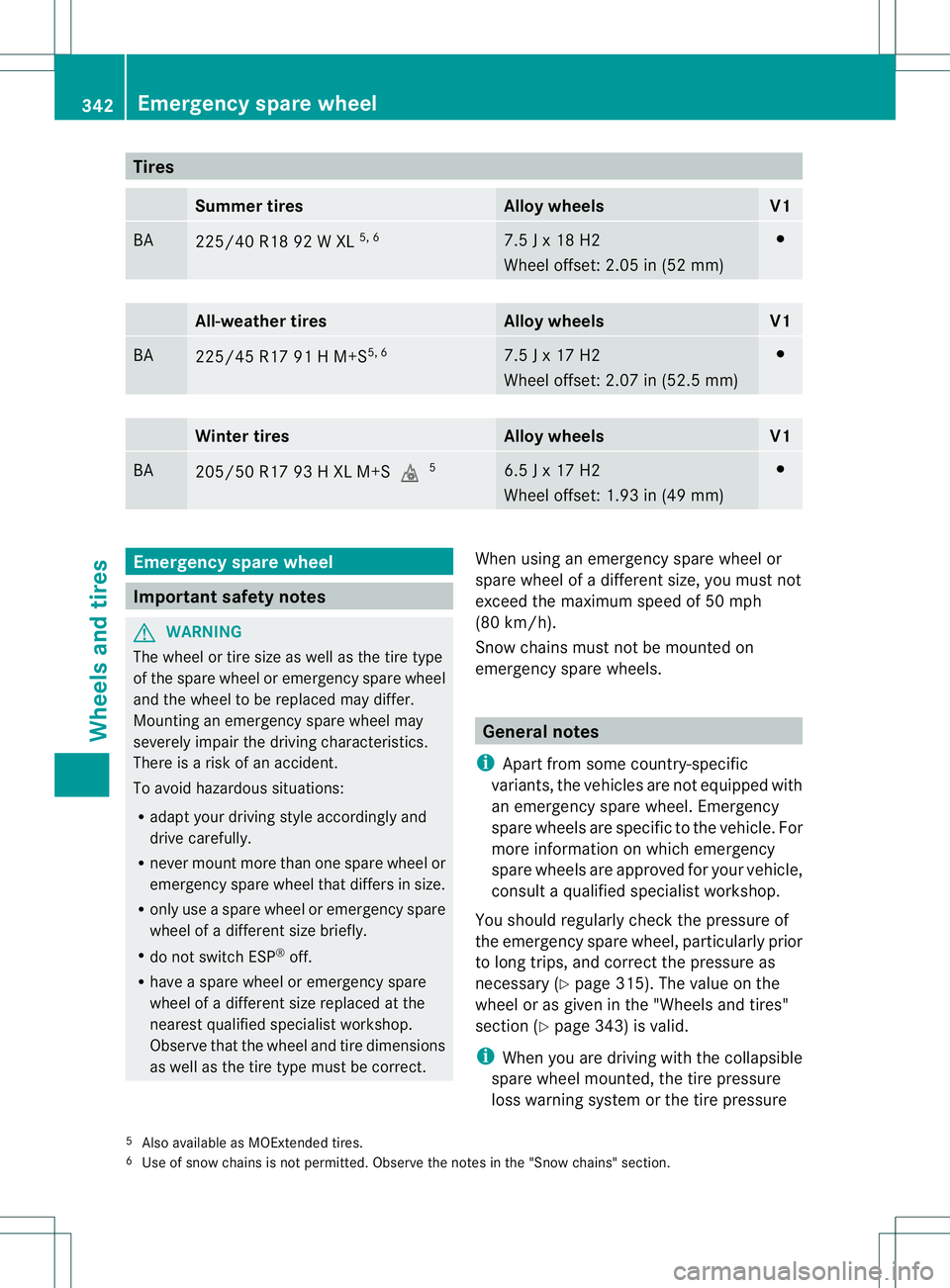
Tires
Summe
rtires Allo
ywheels V1
BA
225/40 R18 92
WXL5, 6 7.5
Jx18H2
Whee loffset: 2.05 in (52 mm) 0012
All-weather tires Alloy wheels V1
BA
225/45 R17 91
HM+S5, 6 7.5
Jx17H2
Whee loffset: 2.07 in (52.5 mm) 0012
Winte
rtires Alloy wheels V1
BA
205/50 R17 93
HXLM+S000E 5 6.5
Jx17H2
Whee loffset: 1.93 in (49 mm) 0012
Emergency spare wheel
Important safety notes
G
WARNING
The wheel or tire size as wel lasthe tire type
of the spare wheel or emergency spare wheel
and the wheel to be replaced may differ.
Mounting an emergency spare wheel may
severely impair the driving characteristics.
There is arisk of an accident.
To avoi dhazardou ssituations:
R adapt you rdriving style accordingly and
drive carefully.
R never mount more than one spare whee lor
emergency spare whee lthat differs in size.
R only use aspare whee loremergency spare
whee lofad ifferent size briefly.
R do not switch ESP ®
off.
R have aspare whee loremergency spare
whee lofad ifferent size replaced at the
nearest qualified specialist workshop.
Observe that the whee land tire dimensions
as wellast he tire type must be correct. When using an emergency spare whee
lor
spare whee lofadifferent size, you must not
exceed the maximu mspee dof50m ph
(80 km/h).
Snow chains must not be mounted on
emergency spare wheels. General notes
i Apart from some country-specific
variants, the vehicles are not equipped with
an emergency spare wheel. Emergency
spare wheels are specifi ctothe vehicle. For
more information on which emergency
spare wheels are approved for your vehicle,
consult aqualified specialist workshop.
You should regularly check the pressure of
the emergency spare wheel, particularly prior
to long trips, and correct the pressure as
necessary (Y page 315). The value on the
wheel or as given in the "Wheels and tires"
section (Y page 343) is valid.
i When you are driving with the collapsible
spare wheel mounted, the tire pressure
loss warning system or the tire pressure
5 Also available as MOExtended tires.
6 Use of snow chains is not permitted. Observe the notes in the "Snow chains" section. 342
Emergency sparew
heelWheels and tires
Page 345 of 360
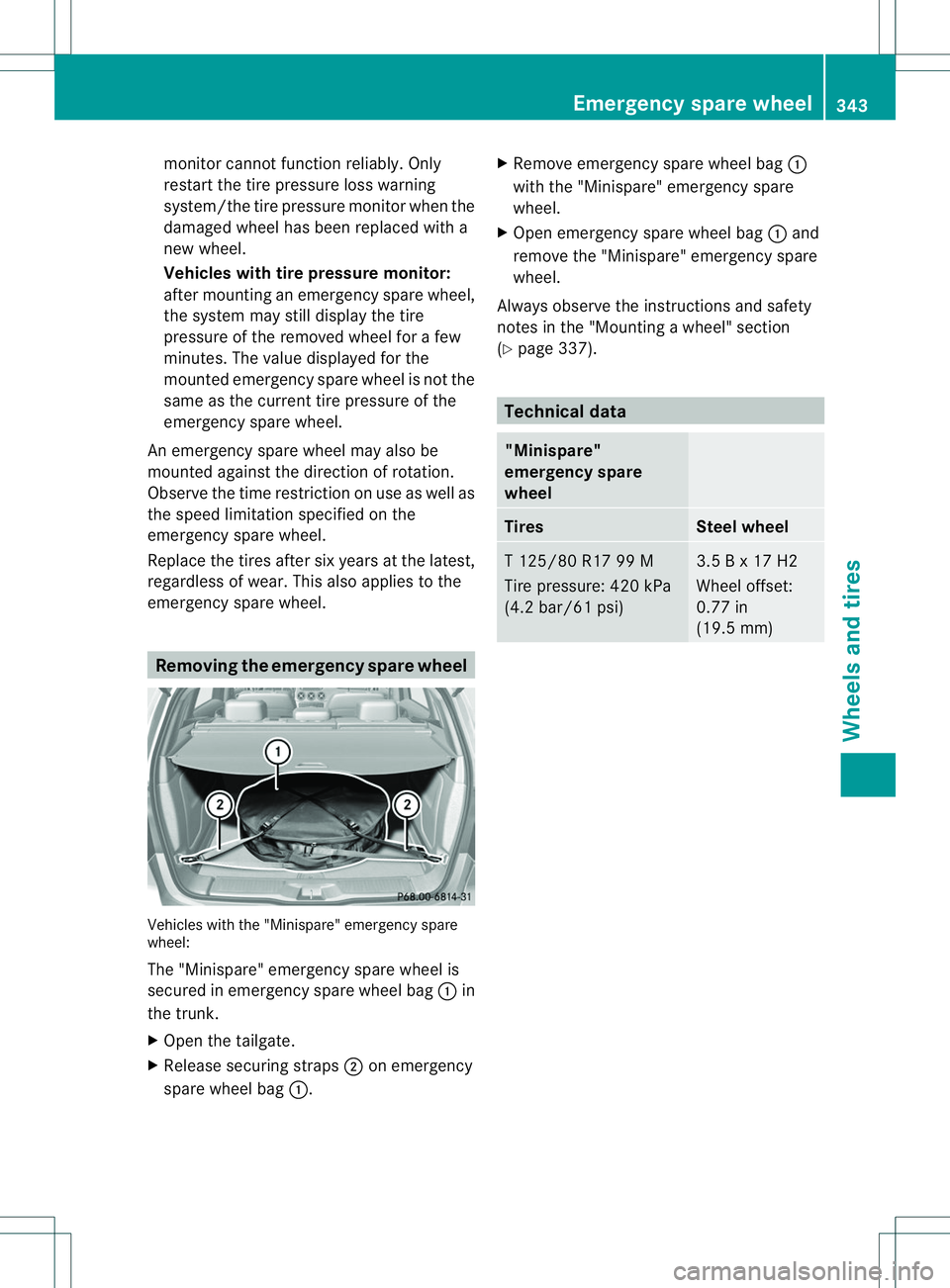
monitor cannot function reliably. Only
restart the tire pressure loss warning
system/the tire pressure monitor when the
damaged whee lhas been replaced with a
new wheel.
Vehicles with tire pressure monitor:
after mounting an emergency spare wheel,
the system may still display the tire
pressure of the removed whee lfor afew
minutes. The value displayed for the
mounted emergenc yspare wheel is not the
same as the current tire pressure of the
emergenc yspare wheel.
An emergenc yspare wheel may also be
mounted against the direction of rotation.
Observe the time restriction on use as well as
the speed limitation specified on the
emergenc yspare wheel.
Replace the tires after six years at the latest,
regardless of wear. This also applies to the
emergenc yspare wheel. Removing the emergency sparew
heelVehicles with the "Minispare" emergenc
yspare
wheel:
The "Minispare" emergenc yspare wheel is
secured in emergenc yspare wheel bag 001Ain
the trunk.
X Open the tailgate.
X Release securing straps 0010on emergency
spare wheel bag 001A. X
Remove emergenc yspare wheel bag 001A
with the "Minispare" emergenc yspare
wheel.
X Open emergenc yspare wheel bag 001Aand
remove the "Minispare" emergenc yspare
wheel.
Always observe the instructions and safety
notes in the "Mounting awheel" section
(Y page 337). Technical data
"Minispare"
emergency spare
wheel
Tires Steel wheel
T1
25/80 R17 99 M
Tire pressure: 420 kPa
(4.2 bar/61 psi) 3.5
Bx17H2
Wheel offset:
0.77 in
(19.5 mm) Emergency sparew
heel
343Wheels and tires Z